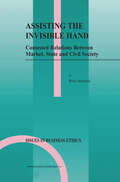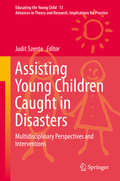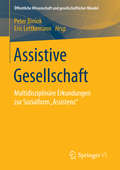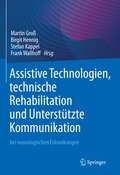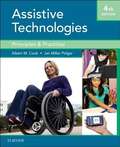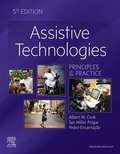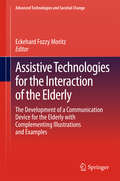- Table View
- List View
Assisting Students with Language Delays in the Classroom: A Practical Language Programme
by Francesca Bierens'Assisting Students with Language Delays in the Classroom' is a structured language programme designed for teachers and SENCOs to use in the classroom with children and adolescents with a range of language abilities. This resource caters to the needs of a broad range of students who require assistance with their language development, from the pre-verbal skills of language, progressing through to the skills required for effective, interactive conversation. The resource is accordingly structured within three key sections: the Pre-Verbal Skills of Language; the Building Bricks of Language; and the Skills of Conversation. Features: step-by-step instructions; language charts 200+ activities and exercise. Francesca Bierens is a Qualified Speech and Language Therapist and Primary School Teacher with over 33 years experience working with children with speech and language delays and/or disorders, in the Education, Health and Private sectors.
Assisting Students with Language Delays in the Classroom: A Practical Language Programme
by Francesca Bierens'Assisting Students with Language Delays in the Classroom' is a structured language programme designed for teachers and SENCOs to use in the classroom with children and adolescents with a range of language abilities. This resource caters to the needs of a broad range of students who require assistance with their language development, from the pre-verbal skills of language, progressing through to the skills required for effective, interactive conversation. The resource is accordingly structured within three key sections: the Pre-Verbal Skills of Language; the Building Bricks of Language; and the Skills of Conversation. Features: step-by-step instructions; language charts 200+ activities and exercise. Francesca Bierens is a Qualified Speech and Language Therapist and Primary School Teacher with over 33 years experience working with children with speech and language delays and/or disorders, in the Education, Health and Private sectors.
Assisting the Invisible Hand: Contested Relations Between Market, State and Civil Society (Issues in Business Ethics #18)
by W. DubbinkThis is an investigation into contemporary thinking on controlling the market, especially with regard to the problem of dealing with environmental issues. The book contributes to contemporary insight by arguing that the issue of market control must be addressed in terms of the relations between state, market and civil society. It stresses the normative dimensions of the market control issue. The position adopted by the book is that the market cannot be controlled by the state alone.
Assisting Victims of Terrorism: Towards a European Standard of Justice
by Rianne Letschert Antony Pemberton Ines StaigerThe fight against terrorism is receiving increased awareness due to recent wor- wide large-scale terrorist acts, and only since then has some attention been directed specifically to victims of terrorism. Existing legal instruments of international b- ies like the European Union, the Council of Europe and the United Nations c- cerning victims of terrorism are relatively abstract or include victims of terrorism under the broader heading of victims of crime in general. In addition, policies and legislation relating to victims of crime or victims of terrorism vary widely on the domestic level. Against this background, the European Union commissioned a project that should aim to develop more extensive standards for the aid and ass- tance of victims of terrorism at the European level. This study provides the basis from which more extensive standards could be derived. The study focuses parti- larly on developing standards in the field of continuing assistance, access to justice, administration of justice and compensation to victims of terrorism. A novel feature of the approach is that also the possible utility of restorative justice approaches is examined. An important question to address was whether there is a real need to adopt s- cific standards for victims of terrorism, thereby implying that their needs might differ from victims of ordinary crime.
Assisting Young Children Caught in Disasters: Multidisciplinary Perspectives and Interventions (Educating the Young Child #13)
by Judit SzenteThis volume discusses 14 different types of disasters and their implications on the social, emotional and academic development of young children, from birth through age eight. It focuses on human-related crises and disasters such as community violence exposure; war and terrorism; life in military families; child trafficking; parent migration; radiation disasters; HIV/AIDS; and poverty. The environment-related disasters addressed in this book include hunger; hurricanes; earthquakes; frostbites; wildfires; and tornadoes. The volume includes suggestions for interventions, such as using picture books with young children in coping with natural disasters and human crises. In addition, each chapter provides research-based strategies for early childhood and related professionals to be used in the classroom. Many children in our world today experience some type of disasters and/or crises. These crises or disasters can either be human- or environment-related and can interrupt children’s daily lives. They often negatively impact children’s development, education, and safety. Bringing together authors representing a variety of countries including Australia, Canada, China, Finland, Haiti, Hungary, Kenya, USA, and Zimbabwe, this book provides truly global perspectives on the various types of disasters and their implications for our work with young children.
Assistive Augmentation (Cognitive Science and Technology)
by Jochen Huber Roy Shilkrot Pattie Maes Suranga NanayakkaraThis book addresses Assistive Augmentation, highlighting the design and development of assistive technologies, user interfaces, and interactions that seamlessly integrate with a user’s mind, body, and behavior, providing an enhanced perception. Our senses are the dominant channel we use to perceive the world around us. Whether they have impairments or not, people often find themselves at the limits of their sensorial capabilities. Some seek assistive or enhancing devices that enable them to carry out specific tasks or even transform them into a “superhuman” with capabilities well beyond the ordinary. The overarching topic of this book revolves around the design and development of technologies and interfaces that provide enhanced physical, sensorial and cognitive capabilities: “Assistive Augmentation”. The Assistive Augmentation community convened at an interdisciplinary workshop at the 2014 International Conference on Human Factors in Computing Systems (CHI) in Toronto, Canada. The community is comprised of researchers and practitioners who work at the junction of human–computer interaction, assistive technology and human augmentation. This edited volume, which represents the first tangible outcome of the workshop, presents stimulating discussions on the challenges of Assistive Augmentation as examined through case studies. These studies focus on two main areas: (1) Augmented Sensors and Feedback Modalities, and (2) Design for Assistive Augmentation.
Assistive Gesellschaft: Multidisziplinäre Erkundungen zur Sozialform „Assistenz“ (Öffentliche Wissenschaft und gesellschaftlicher Wandel)
by Peter Biniok Eric LettkemannDie Beiträge des Buches befassen sich mit der Frage, was ‚Gesellschaft‘ bedeutet, wenn nahezu alle Lebensbereiche assistiert werden. Ob Blindenhund, Butler oder Assistent der Geschäftsführung, Herzschrittmacher oder Navigationssystem, Pflegeroboter oder Ambient Assisted Living - wir werden assistiert von anderen Personen und Lebewesen, und immer häufiger auch von Technologien und Artefakten. Diesen Assistenten kommt eine spezifische und neue Rolle zu: sie beschützen, sie helfen, sie steuern uns. Prozesse der Assistierung in Lebens- und Arbeitswelt werden oft im Einklang mit sich steigernden Kompensations- und Effizienzversprechen vorangetrieben. Aber wie gestaltet sich Assistenz konkret? Welche Wechselwirkungen entstehen zwischen den beteiligten Instanzen? Und welche gesellschaftlichen Dynamiken und unbeabsichtigten Folgen sind damit verbunden? Darauf versucht der Sammelband Antworten zu geben.
Assistive Technologien im Sozial- und Gesundheitssektor (Gesundheit. Politik - Gesellschaft - Wirtschaft)
by Sandra Verena Müller Ernst-Wilhelm Luthe Ina SchieringInwiefern kann die Verwendung assistiver Technologien im Sozial- und Gesundheitssektor eine Antwort sein auf drängende Fragen des demografischen Wandels, des sektoralen Fachkräftemangels und der gesellschaftlichen Teilhabe vulnerabler Personen? Sind sie ein wünschenswerter Beitrag zur Selbstbestimmung und Erhöhung der Versorgungssicherheit der Bevölkerung oder eine fatale Entwicklung hin zu einer Ökonomisierung unserer Hilfesysteme? Das Buch nimmt hierzu Stellung aus unterschiedlichen Richtungen: medizinisch, psychologisch, ökonomisch, rechtlich, gesellschaftswissenschaftlich und aus Sicht der Informatik. Mit seinem Erscheinen in der Reihe „Gesundheit. Politik-Gesellschaft-Wirtschaft“ (hrsg. von E.-W. Luthe und J.N. Weatherly) steht das Buch für die wachsende Erkenntnis, Gesundheitspolitik als interdisziplinäre Aufgabe zu betrachten.
Assistive Technologien, technische Rehabilitation und Unterstützte Kommunikation: bei neurologischen Erkrankungen
by Martin Groß Birgit Hennig Stefan Kappel Frank WallhoffDas interdisziplinäre Grundlagenwerk informiert aus der Perspektive von Neurologie, Rehabilitation, Ingenieurwesen, Pädagogik und Physiotherapie sowie aus Sicht der Patienten über Möglichkeiten und Grenzen des Einsatzes von Technik, um die Teilhabe neurologisch erkrankter Menschen zu verbessern. Ziel des Buches ist, allen Berufsgruppen, die an der Behandlung schwer und komplex erkrankter neurologischer Patienten beteiligt sind, ein umfassendes Verständnis assistiver und rehabilitativer Technologien zu vermitteln.
Assistive Technologies: Principles And Practice (PDF)
by Albert M. Cook Janice Miller PolgarIt's here: the latest edition of the one text you need to master assistive strategies, make confident clinical decisions, and help improve the quality of life for people with disabilities. Based on the Human Activity Assistive Technology (HAAT) model, Assistive Technologies: Principles and Practice, 4th Edition provides detailed coverage of the broad range of devices, services, and practices that comprise assistive technology, and focuses on the relationship between the human user and the assisted activity within specific contexts. Updated and expanded, this new edition features coverage of new ethical issues, more explicit applications of the HAAT model, and a variety of global issues highlighting technology applications and service delivery in developing countries. Human Activity Assistive Technology (HAAT) framework demonstrates assistive technology within common, everyday contexts for more relevant application. Focus on clinical application guides you in applying concepts to real-world situations. Review questions and chapter summaries in each chapter help you assess your understanding and identify areas where more study is needed. Content on the impact of AT on children and the role of AT in play and education for children with disabilities demonstrates how AT can be used for early intervention and to enhance development. Coverage of changing AT needs throughout the lifespan emphasizes how AT fits into people's lives and contributes to their full participation in society. Principles and practice of assistive technology provides the foundation for effective decision-making. NEW! Global issues content broadens the focus of application beyond North America to include technology applications and service delivery in developing countries. NEW! Ethical issues and occupational justice content exposes you to vital information as you start interacting with clients. NEW! More case studies added throughout the text foster an understanding of how assistive technologies are used and how they function. NEW! Updated content reflects current technology and helps keep you current. NEW! Explicit applications of the HAAT model in each of the chapters on specific technologies and more emphasis on the interactions among the elements make content even easier to understand.
Assistive Technologies and Environmental Interventions in Healthcare: An Integrated Approach
by Lynn Gitlow Kathleen FleckyProviding a holistic and client-centered approach, Assistive Technologies and Environmental Interventions in Healthcare explores the individual’s needs within the environment, examines the relationship between disability and a variety of traditional and cutting-edge technologies, and presents a humanistic discussion of Technology-Environment Intervention (TEI). Written by a multidisciplinary team of authors, this text introduces readers to a variety of conceptual practice models and the clinical reasoning perspectives. It also provides insight into how designers go about solving human-tech problems, discusses best practices for both face-to-face and virtual teams, and looks at the psychological, sociocultural, and cognitive factors behind the development and provision of assistive technologies. Examines a wide range of technologies and environmental interventions Demonstrates how a better understanding of the complexity of human interaction with both the physical and social environment can lead to better use of technology Explores the future of technology and research in TEI Complete with a range of learning features such as keywords, case studies and review questions, this book is ideal for undergraduate and graduate students in occupational therapy and other related health professions, as well as those undertaking certification and board examinations.
Assistive Technologies and Environmental Interventions in Healthcare: An Integrated Approach
by Lynn Gitlow Kathleen FleckyProviding a holistic and client-centered approach, Assistive Technologies and Environmental Interventions in Healthcare explores the individual’s needs within the environment, examines the relationship between disability and a variety of traditional and cutting-edge technologies, and presents a humanistic discussion of Technology-Environment Intervention (TEI). Written by a multidisciplinary team of authors, this text introduces readers to a variety of conceptual practice models and the clinical reasoning perspectives. It also provides insight into how designers go about solving human-tech problems, discusses best practices for both face-to-face and virtual teams, and looks at the psychological, sociocultural, and cognitive factors behind the development and provision of assistive technologies. Examines a wide range of technologies and environmental interventions Demonstrates how a better understanding of the complexity of human interaction with both the physical and social environment can lead to better use of technology Explores the future of technology and research in TEI Complete with a range of learning features such as keywords, case studies and review questions, this book is ideal for undergraduate and graduate students in occupational therapy and other related health professions, as well as those undertaking certification and board examinations.
Assistive Technologies- E-Book: Principles and Practice
by Albert M. Cook Janice Miller Polgar- NEW! Global issues content broadens the focus of application beyond North America to include technology applications and service delivery in developing countries. - NEW! Ethical issues and occupational justice content exposes you to vital information as you start interacting with clients. - NEW! More case studies added throughout the text foster an understanding of how assistive technologies are used and how they function. - NEW! Updated content reflects current technology and helps keep you current. - NEW! Explicit applications of the HAAT model in each of the chapters on specific technologies and more emphasis on the interactions among the elements make content even easier to understand.
Assistive Technologies- E-Book: Principles and Practice
by Albert M. Cook Janice Miller Polgar Pedro EncarnaçãoMaster the assistive strategies you need to make confident clinical decisions and help improve the quality of life for people with disabilities. Based on the Human Activity Assistive Technology (HAAT) model developed by Al Cook, Sue Hussey and Jan Polgar, Assistive Technologies: Principles & Practice, 5th Edition, provides detailed coverage of the broad range of devices, services, and practices that comprise assistive technology. This new text offers a systematic process for ensuring the effective application of assistive technologies — and focuses on the relationship between the human user and the assisted activity within specific contexts. It features over 30 new photos and illustrations, as well as, updated chapters and case studies that reflect current technology.Human Activity Assistive Technology (HAAT) framework locates assistive technology within common, everyday contexts for more relevant application.Focus on clinical application guides application of concepts to real-world situations.Study questions and chapter summaries in each chapter help assessment of understanding and identification of areas where more study is needed.Coverage of changing AT needs throughout the lifespan emphasizes how AT fits into people’s lives and contributes to their full participation in society.Principles and practice of assistive technology provide the foundation for effective reasoning.Ethical issues content provides vital information to guide AT service delivery.Explicit applications of the HAAT model in each of the chapters on specific technologies and more emphasis on the interactions among the elements make content even easier to understand.New! Thoroughly updated chapters to reflect current technology and practice.New! Expanded discussion on assistive robotics and smart technologies.New! Review of global initiatives on Assistive Technology.New! Updated art program with 30+ new photos and illustrations.New! Updated case studies to reflect changes in technology and practice since last edition.
Assistive Technologies for People with Diverse Abilities (Autism and Child Psychopathology Series)
by Giulio E. Lancioni Nirbhay N. SinghThe familiar image of the disabled tends to emphasize their limitations and reduced quality of life. However, many people with cognitive, motor, and other difficulties also have the capacity to enhance their social interactions, leisure pursuits and daily activities with the aid of assistive technology. Assistive devices from the simple to the sophisticated, have become essential to intervention programs for this population. And not surprisingly the numbers of devices available are growing steadily.Assistive Technologies for People with Diverse Abilities offers expert analysis of pertinent issues coupled with practical discussion of solutions for effective support. Its comprehensive literature review describes current and emerging devices and presents evidence-based guidelines for matching promising technologies to individuals. Program outcomes are assessed, as are their potential impact on the future of the field. In addition, chapters provide detailed descriptions of the personal and social needs of the widest range of individuals with congenital and acquired conditions, including: Acquired brain damage.Communication impairment.Attention and learning difficulties (with special focus on college students).Visual impairment and blindness.Autism spectrum disorders.Behavioral and occupational disorders.Alzheimer's disease.Severe, profound and multiple impairments.The scope and depth of coverage makes Assistive Technologies for People with Diverse Abilities an invaluable resource for researchers, professionals and graduate students in developmental psychology, rehabilitation medicine, educational technology, occupational therapy, speech pathology and clinical psychology.
Assistive Technologies for the Interaction of the Elderly: The Development of a Communication Device for the Elderly with Complementing Illustrations and Examples (Advanced Technologies and Societal Change)
by Eckehard Fozzy MoritzThis book presents a wealth of insights and new conceptualizations for the development of Assistive Technologies for the Interaction of the Elderly. The book arranges the chapters according to important aspects of maximizing the use value in innovation projects. Every chapter will include an executive summary reporting the main results, a storyline using everyday language, and scientific excursions, wherever useful. The book shows how an innovation project should be structured towards maximum use value and how a project should be structured in order to make a difference. It describes the useful categorization of the large group of the elderly to maximize the focus of the innovation and demonstrates the user involvement into innovation activities. Of course, the assessment of such innovative projects is discussed as well as the “lessons learned”. The book also explores the business opportunities and the financial evaluation of aspects of assistive technology.
Assistive Technology: Interventions for Individuals with Severe/Profound and Multiple Disabilities (Autism and Child Psychopathology Series)
by Giulio E Lancioni Jeff Sigafoos Mark F. O'Reilly Nirbhay N. SinghFor people with severe/profound and multiple disabilities, managing the basic necessities of daily life often poses myriad challenges. Despite great odds, advances in assistive technology are making a difference in these individuals’ lives. Advances in microswitches, voice outcome communication aids, and computer-based systems are creating new opportunities for living independently, improving basic life skills, and reducing problem behaviors among individuals with combined motor, sensory, and intellectual disabilities.This unique volume examines how education and rehabilitation can improve the lives of even those individuals most affected by severe/profound and multiple disabilities. Interventions currently in use and in experimental stages are surveyed in terms of how they work and their applicability to clients with various needs. In addition, it examines the characteristics of developmentally disabled populations and offers guidelines for choosing suitable technologies. It presents empirical evidence on the advances in improving interaction with caregivers, control of the home environment, handling self-care tasks, and other core skills. Assistive Technology examines interventions that are innovative, respectful of the dignity of clients, and practical for ongoing use, including:• Microswitches in habilitation programs.• Speech-generating devices for communication and social development.• Instructional technology for promoting academic, work, and leisure skills.• Assistive technology for promoting ambulation.• Orientation systems for promoting movement indoors.• Assistive technology for reducing problem behaviors.A state-of-the-art guide to a growing field, Assistive Technology is an invaluable resource for researchers, clinicians, graduate students as well as clinicians and allied professionals in developmental psychology, rehabilitation and rehabilitative medicine, learning and instruction, occupational therapy, speech-language pathology, and educational technology.
Assistive technology assessment for pupils with vision impairment (CFVI Resource)
by RnibThis RNIB guide has been updated (2023). It gives information and advice to anybody involved in deciding what equipment to provide a young person in an educational setting to help them overcome the barriers caused by vision impairment. The range of equipment available is considered in broad terms. Relevant aspects of the context in which the equipment will be used are considered. The process of assessment including setting-up the equipment, training, technical support, evaluation and re-assessment are discussed.
Assistive Technology Assessment Handbook (Rehabilitation Science in Practice Series)
by Stefano Federici Marcia SchererAssistive Technology Assessment Handbook, Second Edition, proposes an international ideal model for the assistive technology assessment process, outlining how this model can be applied in practice to re-conceptualize the phases of an assistive technology delivery system according to the biopsychosocial model of disability. The model provides reference guidelines for evidence-based practice, guiding both public and private centers that wish to compare, evaluate, and improve their ability to match a person with the correct technology model. This second edition also offers a contribution to the Global Cooperation on Assistive Technology (GATE) initiative, whose activities are strongly focused on the assistive products service delivery model. Organized into three parts, the handbook: gives readers a toolkit for performing assessments; describes the roles of the assessment team members, among them the new profession of psychotechnologist; and reviews technologies for rehabilitation and independent living, including brain–computer interfaces, exoskeletons, and technologies for music therapy. Edited by Stefano Federici and Marcia J. Scherer, this cross-cultural handbook includes contributions from leading experts across five continents, offering a framework for future practice and research.
Assistive Technology Assessment Handbook (Rehabilitation Science in Practice Series)
by Stefano Federici Marcia SchererAssistive Technology Assessment Handbook, Second Edition, proposes an international ideal model for the assistive technology assessment process, outlining how this model can be applied in practice to re-conceptualize the phases of an assistive technology delivery system according to the biopsychosocial model of disability. The model provides reference guidelines for evidence-based practice, guiding both public and private centers that wish to compare, evaluate, and improve their ability to match a person with the correct technology model. This second edition also offers a contribution to the Global Cooperation on Assistive Technology (GATE) initiative, whose activities are strongly focused on the assistive products service delivery model. Organized into three parts, the handbook: gives readers a toolkit for performing assessments; describes the roles of the assessment team members, among them the new profession of psychotechnologist; and reviews technologies for rehabilitation and independent living, including brain–computer interfaces, exoskeletons, and technologies for music therapy. Edited by Stefano Federici and Marcia J. Scherer, this cross-cultural handbook includes contributions from leading experts across five continents, offering a framework for future practice and research.
Assistive Technology Design for Intelligence Augmentation (Synthesis Lectures on Assistive, Rehabilitative, and Health-Preserving Technologies)
by Stefan CarmienAssistive Technology Design for Intelligence Augmentation presents a series of frameworks, perspectives, and design guidelines drawn from disciplines spanning urban design, artificial intelligence, sociology, and new forms of collaborative work, as well as the author's experience in designing systems for people with cognitive disabilities. Many of the topics explored came from the author's graduate studies at the Center for LifeLong Learning and Design, part of the Department of Computer Science and the Institute of Cognitive Science at the University of Colorado, Boulder. The members of the Center for LifeLong Learning and Design came from a wide range of design perspectives including computer science, molecular biology, journalism, architecture, assistive technology (AT), urban design, sociology, and psychology. The main emphasis of this book is to provide leverage for understanding the problems that the AT designer faces rather than facilitating the design process itself. Looking at the designer's task with these lenses often changes the nature of the problem to be solved. The main body of this book consists of a series of short chapters describing a particular approach, its applicability and relevance to design for intelligence augmentation in complex computationally supported systems, and examples in research and the marketplace. The final part of the book consists of listing source documents for each of the topics and a reading list for further exploration. This book provides an introduction to perspectives and frameworks that are not commonly taught in presentations of AT design which may also provide valuable design insights to general human-computer interaction and computer-supported cooperative work researchers and practitioners.
Assistive Technology for Blindness and Low Vision (Rehabilitation Science in Practice Series)
by Roberto Manduchi Sri KurniawanAssistive technology has made it feasible for individuals with a wide range of impairments to engage in many activities, such as education and employment, in ways not previously possible. The key factor is to create consumer-driven technologies that solve the problems by addressing the needs of persons with visual impairments. Assistive Technology for Blindness and Low Vision explores a broad range of technologies that are improving the lives of these individuals. Presenting the current state of the art, this book emphasizes what can be learned from past successful products, as well as what exciting new solutions the future holds.Written by world-class leaders in their field, the chapters cover the physiological bases of vision loss and the fundamentals of orientation, mobility, and information access for blind and low vision individuals. They discuss technology for multiple applications (mobility, wayfinding, information access, education, work, entertainment), including both established technology and cutting-edge research. The book also examines computer and digital media access and the scientific basis for the theory and practice of sensory substitution.This volume provides a holistic view of the elements to consider when designing assistive technology for persons with visual impairment, keeping in mind the need for a user-driven approach to successfully design products that are easy to use, well priced, and fill a specific need. Written for a broad audience, this book provides a comprehensive overview and in-depth descriptions of current technology for designers, engineers, practitioners, rehabilitation professionals, and all readers interested in the challenges and promises of creating successful assistive technology.
Assistive Technology for Blindness and Low Vision (Rehabilitation Science in Practice Series)
by Roberto Manduchi Sri KurniawanAssistive technology has made it feasible for individuals with a wide range of impairments to engage in many activities, such as education and employment, in ways not previously possible. The key factor is to create consumer-driven technologies that solve the problems by addressing the needs of persons with visual impairments. Assistive Technology for Blindness and Low Vision explores a broad range of technologies that are improving the lives of these individuals. Presenting the current state of the art, this book emphasizes what can be learned from past successful products, as well as what exciting new solutions the future holds.Written by world-class leaders in their field, the chapters cover the physiological bases of vision loss and the fundamentals of orientation, mobility, and information access for blind and low vision individuals. They discuss technology for multiple applications (mobility, wayfinding, information access, education, work, entertainment), including both established technology and cutting-edge research. The book also examines computer and digital media access and the scientific basis for the theory and practice of sensory substitution.This volume provides a holistic view of the elements to consider when designing assistive technology for persons with visual impairment, keeping in mind the need for a user-driven approach to successfully design products that are easy to use, well priced, and fill a specific need. Written for a broad audience, this book provides a comprehensive overview and in-depth descriptions of current technology for designers, engineers, practitioners, rehabilitation professionals, and all readers interested in the challenges and promises of creating successful assistive technology.
Assistive Technology for Cognition: A handbook for clinicians and developers (Current Issues in Neuropsychology)
by Brian O'Neill Alex GillespieAssistive technology for cognition is technology which can be used to enable, enhance, or extend cognitive function. This book systematically examines how cutting-edge digital technologies can assist the cognitive function of people with cognitive impairments, with the potential to revolutionize rehabilitation. Technologies are reviewed which direct attention, remind, recognize, prompt, and generally guide people through activities of daily living. Written by experts in neuropsychology and technology development, Assistive Technology for Cognition provides a comprehensive overview of the efficacy of technologies to assist people with brain impairments. Based on the list provided by the International Classification of Function, each chapter covers a different cognitive function; namely, attention, memory, affect, perception, executive function, language, numeracy, sequencing, and navigation onto which existing and future assistive technologies for cognition are mapped. This structure provides in-depth research in an accessible way, and will allow practitioners to move from an assessment of cognitive deficits to the prescription of an appropriate assistive technology for cognition. The chapters also make suggestions for future developments. Assistive Technology for Cognition will be of great interest to clinicians and researchers working in brain injury rehabilitation, technology developers, and also to students in clinical psychology, neuropsychology, and allied health disciplines.
Assistive Technology for Cognition: A handbook for clinicians and developers (Current Issues in Neuropsychology)
by Brian O'Neill Alex GillespieAssistive technology for cognition is technology which can be used to enable, enhance, or extend cognitive function. This book systematically examines how cutting-edge digital technologies can assist the cognitive function of people with cognitive impairments, with the potential to revolutionize rehabilitation. Technologies are reviewed which direct attention, remind, recognize, prompt, and generally guide people through activities of daily living. Written by experts in neuropsychology and technology development, Assistive Technology for Cognition provides a comprehensive overview of the efficacy of technologies to assist people with brain impairments. Based on the list provided by the International Classification of Function, each chapter covers a different cognitive function; namely, attention, memory, affect, perception, executive function, language, numeracy, sequencing, and navigation onto which existing and future assistive technologies for cognition are mapped. This structure provides in-depth research in an accessible way, and will allow practitioners to move from an assessment of cognitive deficits to the prescription of an appropriate assistive technology for cognition. The chapters also make suggestions for future developments. Assistive Technology for Cognition will be of great interest to clinicians and researchers working in brain injury rehabilitation, technology developers, and also to students in clinical psychology, neuropsychology, and allied health disciplines.

